A Proposed Concept of Digital Libraries in Metaverse to Facilitate Education for School Students
Автор: Namira Khorshed Khan, Kaniz Fatema Kanta, Tabammum Haque Pranty, Dip Nandi
Журнал: International Journal of Education and Management Engineering @ijeme
Статья в выпуске: 4 vol.14, 2024 года.
Бесплатный доступ
The Metaverse is an emerging virtual universe that combines technologies such as VR, AR, AI, and IoT, to captivate the user in an artificial universe that blends reality and technology seamlessly. The metaverse provides a plethora of opportunities to vastly expand and realize the capabilities of our imagination as technology materializes ideas into intractable objects for an enhanced experience. The metaverse can also impact the education sector offering a unique opportunity to revolutionize education by providing immersive and interactive learning experiences through 3D avatars. In traditional libraries, students read books to learn about a vast array of topics and can visualize those topics through 2D images provided in the books, but such images might not always be the best stimulus to enhance the reader’s imagination. The introduction and integration of “Digital Libraries” through the Metaverse enable school students to explore various subjects in 3D environments, providing a practical approach to knowledge and improving comprehension, resulting in enjoyable and effective learning experiences. Metaverse enables seamless embodied user communication in real-time and dynamic interactions with digital antiquities. Besides, a digital library is defined as an online database of digital collections. It contains a lot of papers and resources which are arranged digitally. Its benefits include effectiveness, accuracy, authenticity assurance, simpler plagiarism management, easy accessibility, and high convenience. However, it has its drawbacks too such as copyright issues, distractions due to notifications, and various health hazards. In response to those drawbacks, how a digital library may use the Metaverse to add visual and auditory effects to enrich information provided in books has been illustrated, and how digital libraries in the Metaverse have the potential to revolutionize education while also addressing and potentially solving the problems that afflict traditional libraries has been highlighted by suggesting a prototype of the digital library in the Metaverse.
Library, Digital library, Metaverse, AR, VR, Education in Metaverse
Короткий адрес: https://sciup.org/15019321
IDR: 15019321 | DOI: 10.5815/ijeme.2024.04.05
Текст научной статьи A Proposed Concept of Digital Libraries in Metaverse to Facilitate Education for School Students
Throughout history, libraries have traditionally played the customary role of repositories of knowledge and places of learning. However, students can study books with a wealth of information at a regular library. Students frequently struggle to recall material from multiple courses about different fields. This was primarily due to the books not being interesting enough or being too challenging for their developing minds. If everyone could have personally experienced everything and enjoyed the learning process, retaining the knowledge and gaining an in-depth understanding would have been much simpler. The constraints of conventional educational approaches can be overcome by the Metaverse by offering an engaging and dynamic learning environment. Students can easily access a huge information base, overcoming physical limitations and developing a greater understanding of a variety of fields of study. Additionally, the Metaverse gives teachers new methods to convey knowledge, encouraging students' imagination and curiosity by making learning more fun in an immersive environment. That is why to provide an idea of how the digital library can be used in the Metaverse, a prototype has been proposed in this paper.
The primary contribution of this study includes the following ideas:
1) An explanation of a traditional public library, a digital library, the benefits of a digital library, and the challenges of both a digital and a traditional library.
2) The history and concept of the Metaverse, as well as four different technologies employed in it, including augmented reality, virtual reality, artificial intelligence, and the Internet of Things.
3) A crystal-clear representation of a digital library in the Metaverse.
2. Libraries
2.1. Definition of Libraries2.2. Challenges of Public Libraries
The rest of this paper is structured as follows, the background studies regarding the library and challenges of a traditional library are covered in Section 2 of this article. A brief definition of a digital library is included in Section 3. Section 4 and Section 5 represent the benefits and the challenges of a digital library respectively. In Sections 6 and 7, respectively, the Metaverse and the significance of the Metaverse in education are extensively explained. The tool used for representing our concept and how it works is covered in Section 8. In Section 9, a discussion and a prototype are comprised that outlines the implementation of a digital library in the Metaverse. The conclusion is contained in Section 10 for further closure.
Libraries have existed since the beginning of time and have played a crucial role in acting as a store of knowledge for mankind. Although the method of storage has changed with the advancement of society, the primary purpose that libraries serve has not. Libraries perform the basic functions of collecting information, storage, and reading facilities and offer spaces where individuals can study and explore digital media and high technologies [1].
There are many challenges faced by public libraries which include a drop in funds from the government, increased faith of the public in subjective information sources, inability to afford to hire and keep qualified library staff, difficulty in building, renovating, or managing due to excessive property and construction expenses, fall in the number of readers and discontinuation of many library schools. Apart from these reasons, the youth have specifically become susceptible to being addicted to the use of digital devices and are less able to concentrate on the lengthier content of information [2].
There is a strong rise in the number of people who distrust the government, especially in America. The pessimistic view of the government is harmful to the operation of state libraries due to the loss of funding. The issue of trust in the media is also especially worrisome, as large segments of the public distrust the news they receive and increasingly turn to biased sources of information. Many urban areas are now costly, which makes it challenging to hire and keep qualified library staff for the remuneration that libraries can pay. Construction, renovations, or maintenance of buildings in urban areas may be incredibly expensive for some cities because of rising real estate and development costs. Nowadays, youths are particularly vulnerable to gadget addiction, which causes them to lose their capacity to concentrate on lengthy content and disrupts the extremely valuable experience of boredom. Moreover, library schools do not always offer the comprehensive set of skills required for modern library job roles. Numerous library schools have been closed, and student convergence in substantial courses all over the nation, as well as a near-universal rise in popularity toward online learning or hybrid courses, have been seen.
A shocking report titled Reading at Risk published by the National Endowment for the Arts in 2004 documented a significant fall in literary reading between 1982 and 2002. Dana Gioia's remarks about the relationship between reading to social harmony and social activism highlight some of the causes why public libraries should be worried about the decrease in reading. This report unquestionably shows that readers are more engaged and invested in their communities. As a result, the decline in reading corresponds to a greater escape from social and artistic life [3].
User's reliance on library assistance to meet their information needs has decreased because of the widespread use of web search engines and other internet tools and services. Individuals looking for information on the internet are fascinated by the simplicity of use, the online presence of information, easy accessibility, and the efficiency that it provides. Most of the potential library users of today’s generation were born in the digital age and prefer to find information online due to the fun and user-friendly experience that meets their expectations [4].
The prevalent use of web search engines and other internet resources and applications and the introduction of players in the academic information-collecting realm have lowered users' reliance on library assistance to meet their information requirements. The emergence of web-oriented innovations has added an enjoyable element to the user experience; additionally, these advancements lead to exposure to unofficially posted information generated by coworkers and encourage the exchange of digital resources and user expertise. The convenience of use and online accessibility of information that internet search engines, online encyclopedias, and other free and open-source web services provide appeal to the average individual learner. Users place a high value on the easiness of use, accessibility, and pace that define online resources and applications. Web search engines are more exciting to use, provide instant gratification, and are simple to learn. Besides that, users prefer online sources now when necessary and believe that web tools are better suited for locating and acquiring data online since search engines present the data in a user-friendly manner that corresponds to the requirements and knowledge of the anticipated intended audience. Libraries are still unable to offer an equivalent level of coverage, efficiency, or simplicity of usage as web search engines. Many modern readers were born in the digital age, and their academic research practices are closely linked to their ultimate browsing experience.
To further understand the dynamic that digital libraries bring to the table, it should be first understood what digital libraries are.
3. Digital Library
Libraries were particularly interested in utilizing the possibilities of the digital revolution when developments in computer science made it possible to deal with digital representations of documents intended to capture human knowledge and culture rather than printed ones. As a result, "digital libraries" quickly took hold as a phrase to denote the digital equivalent of traditional libraries. However, since their first debut, digital library systems have significantly advanced [5]. An online database of digital collections that may contain text, photos, audio, video, or other digital media formats is known as a digital library. A digital library contains various papers and resources that are arranged digitally and made accessible to users online via the Internet [6]. The information in the digital version is stored on a web server that can be put in a remote place, but consumers may access it from any location using a computer network, making it distinct from the usual library, which consists of a collection of paper books and similar materials. As information repositories or reading assets hubs, digital libraries are anticipated to increase readers' preferences and behavioral patterns [7].
4. Benefits of Digital Libraries
Digital libraries have many advantages over public libraries, including effectiveness, accuracy, authenticity assurance, simpler plagiarism management, easy accessibility, and high convenience. Furthermore, lecturers can create lesson plans without having to comb through stacks of books on shelves and highly cited articles can provide satisfaction for the authors [7]. Digital libraries offer greater effectiveness, accuracy, authenticity assurance, and simpler plagiarism management. Teachers can create lesson plans without paging through stacks of books on shelves. Reading materials that have been virtually stored is simple for pupils to locate and acquire knowledge from. It is convenient for users since digital libraries can be viewed from everywhere.
Many users can access the structured content of the digital library at any time and from any part of the world with the advantage of having a user-friendly interface. Along with providing the ease of resource sharing, the presence of digital libraries omits the issues of space and cost required by traditional libraries [8]. If there is an Internet connection, anyone in the world can access the same information through a digital library without physically visiting the physical location. Access to the information is accessible throughout the day or night, and multiple users can use the same resources concurrently. Digital libraries enable easy navigation from the catalog to a specific book, then to a specific chapter, and so forth. They also offer access to a much greater selection of content. To browse the extensive set, the user can enter any keyword search (term, group of words, headline, title, or topic). The user-friendly interfaces of digital libraries can simplify the process of using their resources. Digital libraries can hold much more data than libraries essentially because digital files necessitate such little physical space to be contained, whilst conventional libraries are constrained by storage space. A seamless integration of information exchange is possible because it is very simple for one digital library to connect with the resources from other digital libraries. The upkeep costs of a digital library are, in theory, less than those of a conventional library. A conventional library must incur significant expenses on things like employees, book upkeep, rent, and new books.
5. Challenges of Digital Libraries
Numerous benefits have come with new technologies for digital libraries but also has given rise to challenges. In a study carried out, the issue identified with digital library collections was less about coverage and more about whether there was any data available for readers to make decisions about authority, precision, currency, and copyrights [9]. The participants in the study were unsure about the authors of the writers and found insufficient citations and no visible copyright information. The cheap distribution of e-texts is more important than the accuracy and quality of the information in digital libraries. All the collections are not always up-to-date and do not even contain accurate dates of publication. According to another research on digital library collections, it was found that “Of the 786 collections examined, 28% consisted entirely of copyrighted items, 28% contained a mix of copyrighted and mixed items, and 41% were composed entirely of public domain items Approximately half of the collections surveyed had copyright statements at the collection or item level. The other half had no statement or had only a link to an institutional statement” [10].
Reading habits that are reduced and divided may be encouraged by modern computer screens due to the resolution and size of screens, compulsion to stay in fixed positions, constant disturbance by notifications, lack of proper environment, and failure to provide the foundation for a more focused and prolonged form of reading [11]. It strains the eyes to look at screens because of their low resolution, flicker, and backlighting. We are generally compelled to sit in one position, which is also exhausting, due to the size and difficulty of repositioning screens and thus attention is quickly affected. The vibration and sounds of digital devices and frequently congested and occupied digital screens cause distraction. Even though we don't necessarily need to have multiple windows open at once, many of us do, and the operating system still demands our focus even when only one tab is open. Although the visually congested multithreaded desktops on which we work are ideal for search, a highly engaging and comparative activity, they are inadequate as a foundation for more focused and perpetuated forms of reading. We often read more deeply and thoroughly when we stay away from outside distractions. The places where we keep our computers, whether in our homes or offices, are often hubs of activity and unsuitable for quiet reflection. It might turn out that locational concerns are equally important for digital libraries and traditional libraries.
Based on these issues, a prototype of digital libraries in the Metaverse has been proposed to eradicate some of the limitations. Before getting to know about the prototype, it is important to know what the Metaverse is and why it plays an important role in education.
6. Metaverse
An emerging virtual universe that has been created outside of the real world is described by the term "Metaverse," a term that is made up of the prefix "meta" which means beyond or transcending, and the prefix "verse" which means the universe [12]. The term "metaverse" was first used by science fiction author Neal Stephenson in his 1992 book "Snow Crash." Stephenson refers to the metaverse in the book as a virtual world within which the main character could flee from the actual one [13]. Any 3D virtual environment supported by technologies like virtual reality (VR), augmented reality (AR), artificial intelligence (AI), the Internet of Things (IoT), and blockchain that enables interactivity among users via non-human avatars is referred to as the Metaverse [14]. Augmented reality will power the metaverse, with each user in possession of a character or avatar. You could, for instance, complete work and unwind in a blockchain-based game while wearing an Oculus VR headset in your virtual office, attend a mixed-reality meeting there, and supervise your cryptocurrency portfolio and money all inside the metaverse [15].
The Metaverse is still regarded as being in its early stages regardless of the enormous interest it has received and the fact that it made its debut in fiction about 30 years ago. Since the end of 2021, when Facebook changed its name to Meta, Google Trends revealed noticeably growing curiosity in the term. The number of scientific articles about the Metaverse also increased. This sharp increase is revealed by examining the publications that are included in the Web of Science database that contain the term "Metaverse" in any area of study. Six publications appeared in 2020 and 32 publications in 2021, but 158 documents were discovered between January and August of 2022 [16].
The three distinct characteristics of Metaverse are "shared," "persistent," and "decentralized" [17]. About the "shared" feature, the Metaverse facilitates barrier-free links between users so they can engage in a variety of social activities (such as discussing, working together on projects, playing games, and solving problems) that resemble real-life scenarios for value creation through multiuser virtual reality systems, regardless of their location on the planet. As for the "persistent" feature, a Metaverse system that has the lifelogging capability to fully capture and digitize the details of its users' lives within it offers an ever-continuous environment in which users can "live" to work, learn, communicate, create, and amuse themselves. Concerning the "decentralized" aspect, the Metaverse uses decentralized technologies like blockchains to ensure the security of users' belongings and records [18].
7. Importance of Metaverse in Education
The limitations of 2D learning platforms can be overcome by using the Metaverse in education to provide both official and informal active learning experiences [19]. Moreover, it facilitates group collaboration among students in a virtual setting where they can design three-dimensional objects representing ideas, principles, or feelings and interact with each other via avatars. One example of how architectural heritage documentation can be learned through Metaverse helps students visualize the Pashedu III Tomb. It is easier to create inclusive, dynamic, learning-centered curricula for educational purposes when knowledge is obtained in the Metaverse. It is possible to remove time and place restrictions on the educational process. Visually appealing learning resources facilitate student learning, pique their interest by making the learning process more interesting and positively impact their behavior [20].
Metaverse combines both AR and VR. Augmented reality (AR) is a technology that precisely overlays real-time physical objects with computer-generated virtual imagery. While teaching subjects like geography and astronomy where students could not realistically gain first-hand experience, AR has the potential to also foster student creativity and imagination, improve communication among learners and educators, and assist students in taking charge of their educational journey at their speed and on their timeline while also helping to create a true atmosphere for learning [21]. The use of virtual reality (VR), a cutting-edge breakthrough in technology, has fundamentally changed how we perceive and engage with digital environments. Modern computer graphics, motion sensors, and display technologies are used in VR to give users the ability to fully immerse themselves in the simulations of real or artificial worlds. The use of augmented reality (AR) and virtual reality (VR) technologies in education has the promise to transform the field and give students a more engaging and interactive learning environment. Students may engross themselves in an array of various visualizations, sound cues, and simulations using these developments, which can boost their curiosity about the subject [22]. Virtual reality (VR) simulations and games give students the chance to put theory into practice, study with tools, hone intricate practical and behavioral abilities, and learn from past errors without having to worry about the seriousness of repercussions or mistakes in the real world [23].
Laboratory simulations (such as safety training), the development of practical abilities (such as surgery), and the study of STEM fields are some of the first fields of use with outstanding outcomes in terms of training efficiency, productivity, and recollection with AR and VR-supported learning. This is about Metaverse's potential for radical innovation in education. The Metaverse can enable engaging reporting to inform the general population reliably and impartially on unidentified circumstances and events in distant regions by enabling the recording of 360-degree panoramic photos and volumetric spherical video. To overcome the limitations of 2D platforms, new models of virtual education powered by the Metaverse may also develop. In permanent, alternative, online 3D virtual campuses where students are members of the interactive environments and collaborators of fluid, tailored instructional experiences, meta-education can enable a rich combination of both formal and informal active education experiences [24].
8. Tools and Methods Used
The images were generated using an image generator named “Leonardo.Ai”, which provides 150 tokens per day for all users signed up on the website. Before the final desired results were attained, various prompts and settings were tried and errored upon. The specific prompts that were used to generate the outcome of each figure are shown in Table 1. The final settings that were used for each image are listed below.
• Input Resolution: 512 x 768px
• Resonance: 15
• Contrast Boost: 0.5
• Pipeline: Alchemy
• Preset: Dynamic
• Prompt Magic Strength: 0.5
• Prompt Magic: V3
• RAW Mode: Off
9. How can a Digital Library be Implemented in Metaverse?
Table 1. Prompt for each figure
|
Figure Number |
Prompt |
|
Fig.1. |
“a school student in front of small screens containing chapter names and titles in Metaverse and touching them” |
|
Fig.2. |
“a student standing in front of different animals and can touch and visualize the parts of the animals in Metaverse in a digital library” |
|
Fig.3. |
“a school student standing in midst of World War II and trying to understand the history chapter in Metaverse” |
|
Fig.4. |
“a school student standing in front of a solar system and touching a planet” |
|
Fig.5. |
“a 3D water cycle diagram is in front of a student in Metaverse to understand the process of water cycle” |
|
Fig.6. |
“a school student standing in front of a simple electronic configuration of an atom and touching its different parts to study the different parts of an atom with protons, neutrons and electron in Metaverse” |
|
Fig.7. |
“a school student standing in front of a simple circuit diagram and touching its different parts to study the different parts of a circuit and how electricity passes in Metaverse” |
|
Fig.8. |
“a school student standing in front of a plant and touching its different parts to study the different parts of a plant with flower and fruit in Metaverse” |
Almost all of us do not remember the various information that we were taught in different subjects during our school time. This was mostly because the books were not captivating enough or too hard to grasp for our young minds. It would have been much easier for us to remember the information if we could experience everything ourselves and enjoy the learning process rather than just paging through the notes to only pass the examinations. In situations like these, Metaverse can play a crucial role. Consider the events of World War II. Using Metaverse, we could put the user on the battlefield where they could see, hear, and relive the events that occurred so that they get imprinted into their memories much more than any words could ever achieve. Alternatively, a large-scale replica of a human tooth could be placed in the hands of a future dentist so they can learn about all the complex components of the tooth. To give a better idea about the implementation of digital libraries in Metaverse, various scenarios have been explained along with images.
Students can devour books by going to the library. There are numerous ways to study in the digital library through Metaverse. There is no need for school students to waste time traveling to physical libraries or going outside to study. In Metaverse, there will be plenty of room to read books. With the demeanor of Metaverse, students will be able to swipe through the screen and instantly access the list of subjects and topics that are offered as shown in Fig.1. They can choose a specific topic or chapter and they will instantly enter a virtual land where a 3D view of the selected topic will appear. Additionally, they will be able to swiftly view all the information through Metaverse if they click any section of the screen they want to read. Besides, there will not be a time restriction for reading books on a virtual screen. Students will also be able to explore any kind of book with practical knowledge. Students will find it simpler to learn about reading books in the metaverse and will be able to become interested.
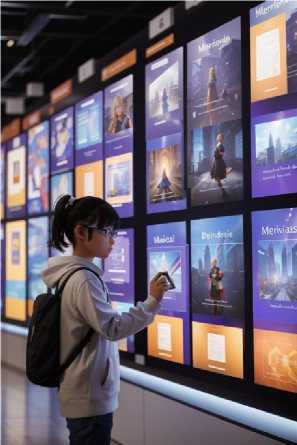
Fig. 1. A school student in front of small screens containing chapter names and titles in Metaverse and touching them.
Visiting a zoo or reading a book about animals are the only ways to learn about various creatures. However, none of the strategies are particularly successful with school children, considering that it is difficult to gather all the animals in a zoo. It will also be expensive. Moreover, organizing a research trip to a zoo for all the school administrators is expensive and complicated. Without their parents, managing such young students can be challenging. Even if a study trip may be set up in a zoo, students will not be able to gain a thorough understanding of the animals. Because they were unable to touch or engage with the animals to learn more about their various body parts. On the other hand, there are numerous possible ways in the Metaverse to use a digital library to teach pupils about animals and their organs. Students will be able to explore and learn about many creatures in this digital recreation of actual zoos and exhibits. Students can interact with 3D animal models, look at specific body parts, and get details about the habitat, behavior, and anatomy of all animals. It will be possible for students to rotate, zoom in, and view various body parts and learn about their respective functions from different viewpoints. This all-encompassing experience can improve comprehension and engagement. An illustration is given in Fig.2. to visualize the scenario.
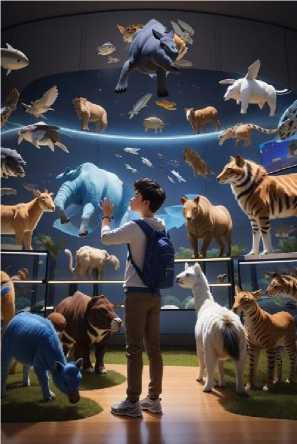
Fig. 2. A student standing in front of different animals and can touch and visualize the parts of the animals in Metaverse in a digital library.
Learning about history is one of the most crucial lessons for any student. For school pupils, it might be challenging to retain much information by reading books only. For instance, World War II was one of the deadliest and most devastating wars in history, causing widespread harm to people's bodies and minds. The impact that World War II had on people and society on a physical and mental level must be acknowledged and remembered. If school kids can see and experience the historical eras, it may be easier and more effective for them to retain and understand history. Through a digital library, the Metaverse can provide creative and immersive methods to discover and learn about historical events like World War II which is picturized in Fig.3. School students can take virtual tours of historically accurate recreations of key locations and battlefields from World War II. To gain a greater understanding of what happened, they can visit renowned landmarks, military museums, bunkers, and other historical locations. Students can navigate between various eras of the battle in a virtual setting to observe how it changed and progressed through time. The pupils will also be able to have a full understanding of the war's effects on various communities and populations, which is impossible because it happened in the past. With a dynamic and engaging learning experience that goes beyond textbooks and videos, students will be able to become more interested in history. It will increase the student’s access to, interest in, and understanding of history.
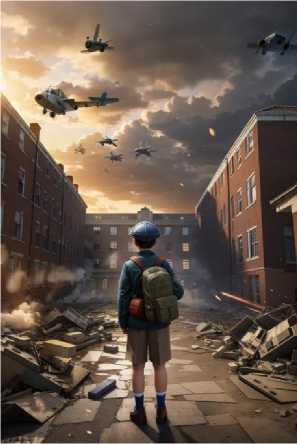
Fig. 3. A school student standing amid World War II and trying to understand the history chapter in Metaverse.
Astronomy is a scientific study of celestial objects, space, and the universe. It aids in comprehending the universe's fundamental nature. Students are always eager to learn more about astronomy because it is such an interesting component of education. Astronomy also includes the study of the solar system. The Solar System hangs in the middle of a surprisingly vacant region of space that cannot be seen with the bare eye. It is impossible to get closer to all that and touch it to learn about it and investigate the entire system to gain a thorough understanding of it. The solar system presents a special environment for exploring the universe and is essential to the operation and existence of life on Earth. Therefore, the pupils must have a thorough understanding of it. But children learn about astronomy through books, pictures, and movies, none of which can provide an accurate understanding. Students will be able to view objects including the sun, planets, moon, and other celestial bodies in a three-dimensional setting in a digital library through the Metaverse as visualized in Fig.4. It will be a digital recreation of the real solar system. Students will be able to rotate, zoom in, investigate each object from different perspectives, touch each object, and obtain relevant information. Such an experience will improve comprehension.
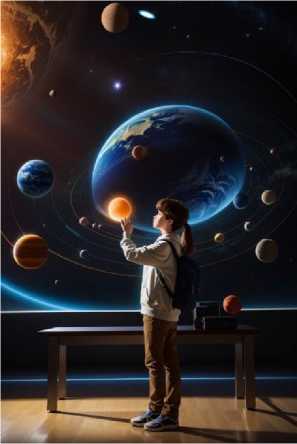
Fig.4. A school student standing in front of a solar system and touching a planet.
Students are taught about the water cycle in either their science or geography classes. The water cycle explains how water vapor from the earth's surface rises into the atmosphere, cools, and condenses to form rain or snow in clouds, and then falls back to the earth's surface as precipitation. A significant portion of the water that falls on Earth accumulates in rivers, lakes, soil, and porous layers of rock before returning to the oceans, where it is going to evaporate yet again [25]. An important factor in weather conditions on Earth is the movement of water in and out of the atmosphere. Since these are natural processes, there is very little scope for the teachers to give the students a practical concept of how the process occurs in nature itself. The 2D drawings and explanations in books provide a somewhat vague idea about the actual procedure. If the water cycle is demonstrated to the students in Metaverse as in Fig.5, then can get a 3D view of the whole process in front of their eyes and get a much more realistic visualization. The students can see each element partaking in the water cycle and tap on a specific part to see much more detail about each object present in the 3D model. For instance, tapping on the cloud will show a screen that contains much more details about the cloud, and so on.
Many school students dread the name of chemistry after seeing the complex atomic structures or chemical reactions in their books. The teachers cannot show the structure of atoms or molecules and the bonds between the atoms practically since they exist only in nature. Different models are used to demonstrate the structures in class, but the actual concept remains indistinct to the students. Some schools don’t have well-organized chemistry labs and the unavailability of proper equipment or chemicals in schools due to the lack of resources, funds, and negligence of the authority. Moreover, the lab experiments are shown in groups to save time and resources which prevents every single student from getting a hands-on learning experience. Using Metaverse, the students can see a 3D atomic structure and tap on its different parts to learn the details of the protons, neutrons, electrons, and electronic shells in depth. They can see how the atoms join to form molecules and perceive a much better understanding which has been conceptualized in Fig.6. Every single student can also get the chance to conduct the experiments by themselves with the guidance of their teachers since there are no bindings to the availability of resources. They can mix different chemicals, see the products, deduce the color changes, apprehend the right measurements of chemicals, and tap on each instrument or chemical to learn about them in more detail. These practical experiences will help the students to enjoy the learning process and grow their enthusiasm to learn more.
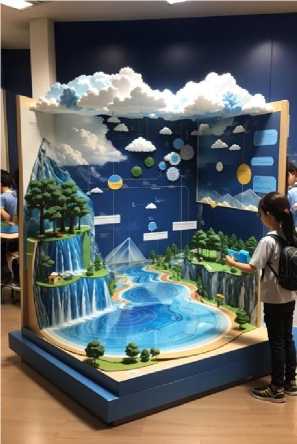
Fig.5. A 3D water cycle diagram is in front of a student in Metaverse to understand the process of the water cycle.
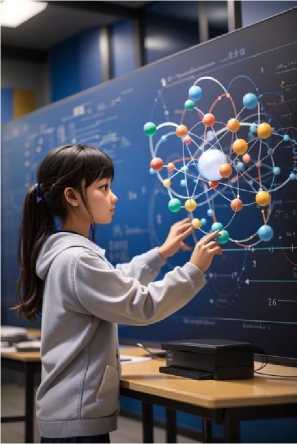
Fig.6. A school student standing in front of a simple electronic configuration of an atom and touching its different parts to study the different parts of an atom with protons, neutrons, and electrons in the Metaverse.
The most common problem faced by most engineering students is that they find the practical labs of electrical subjects very boring and difficult to figure out. This is because during school life the students have only learned about the circuits in books and failed to get the opportunity to gather pragmatic knowledge. Like chemistry labs, physics labs are also short of the appropriate facilities due to the very same reasons. In Metaverse, each student will get the chance to build practical circuits, facilitating a comprehensive knowledge of the different devices like switches, bulbs, wires, etc. as shown in Fig.7. With the advantage of tapping on each component to see more details, students can learn more and explore the questions of their curious little minds to the full extent. This will not only enhance their ability to grasp the subject matter but also retain the concepts for a longer period, diminishing the fright of electrical labs.
School students learn about trees, fruits, and flowers in school in real life. They learn much of the time in school by seeing plants or reading books. Additionally, they can gain experience to view any flower, tree, or fruit via a microscope. However, this system can occasionally be exceedingly challenging. Since no pupil can practically see all the plants at once it is impossible to observe the plants instantly. Because of this, many school students are unable to learn and fail to see. In addition, not all kinds of flowers, plants, or fruits are always in season. As a result, school administrators may fizzle out to see these. On the other hand, if they exert the metaverse, it will be more salutary for the students. Students will be able to explore any sort of plant effortlessly in virtual reality as picturized in Fig.8. When they touch a particular plant, they will be able to see its specification. As a result, students can become acquainted more with any aspect of the plants as well as observe and interact with them. Moreover, it will take less time. And finally, this will be fantastic for learning something new through the Metaverse as well as for gaining information and experience.
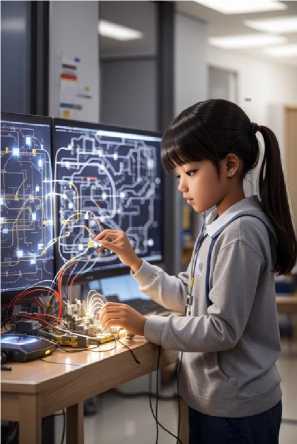
Fig.7. A school student standing in front of a simple circuit diagram and touching its different parts to study the different parts of a circuit and how electricity passes in the Metaverse.
By using this prototype, the concept of the digital library can be implemented in the Metaverse. Compared to traditional libraries, the idea of a digital library is more practical. In contrast to traditional libraries, which rely on tangible holdings, digital libraries use technology to store, arrange, retrieve, and provide online access to all their materials. Along with providing students with a more engaging and enjoyable learning environment, the digital library in the Metaverse can provide people with access to a wide range of documents and materials from any place and at any time of the day. The copyright issues of digital libraries can also be solved since Metaverse uses blockchain technology to offer a more secure environment for its users. Its powerful search capabilities make it easy for users to find specific information. It simplifies sharing and teamwork. Using a digital library that makes use of Metaverse could be the easiest way to learn. Digital libraries, as opposed to traditional libraries, allow students to interact with touch screens that display names and chapter titles from the Metaverse. They will also be able to see, touch, and interact with different objects in the Metaverse of a digital library. The digital library in Metaverse could not be implemented in real life due to inadequate resources; however, this prototype should lead to a more effective use of it in the future. It is meant to be improved and implemented in the future, which demands a lot of work and time to accomplish, but it is possible with the appropriate resources.

Fig.8. A school student standing in front of a plant and touching its different parts to study the different parts of a plant with flowers and fruits in Metaverse.
10. Conclusion
A ground-breaking study in the field of educational renaissance is set to alter the course of learning for students in schools by utilizing the power of digital libraries within the immersive Metaverse. This ambitious study not only creates a deployable digital library design for the Metaverse but also reveals a rich tapestry of how this fusion might benefit students in their pursuit of dynamic, quick, and efficient knowledge acquisition. The study's core lies in its capacity to transcend the conventional paradigms of learning. A symphony of transformational learning results from the union of the infinite world of digital libraries with the limitless potential of the Metaverse. As a result of this convergence, education takes on a dynamic narrative in which students travel through virtual environments equipped with digital instruments and gather knowledge from the informational tree that is always growing. The Metaverse, a theater of unending wonder, transforms into a world where literature pulsates, science breathes, and history is alive, creating an educational experience that fosters engagement, encourages inquiry, and stokes the fires of comprehension.
This daring journey is not without difficulties, though. Although the vision is broad, the present is limited by a lack of resources and the unrelenting passage of time. The research recognizes the Metaverse's emerging role in education and the complex dance between idealized ideals and practical realities. The research still serves as a testimony to the promise of the unexplored despite these difficulties. It depicts a future in which students, equipped with the nexus of digital libraries and the Metaverse, emerge not just as information recipients but also as creators of their intellectual future. The study's vision is destined to unfold as resources line up and technology develops, weaving a tapestry where education and innovation dance in unison to create a better world.


